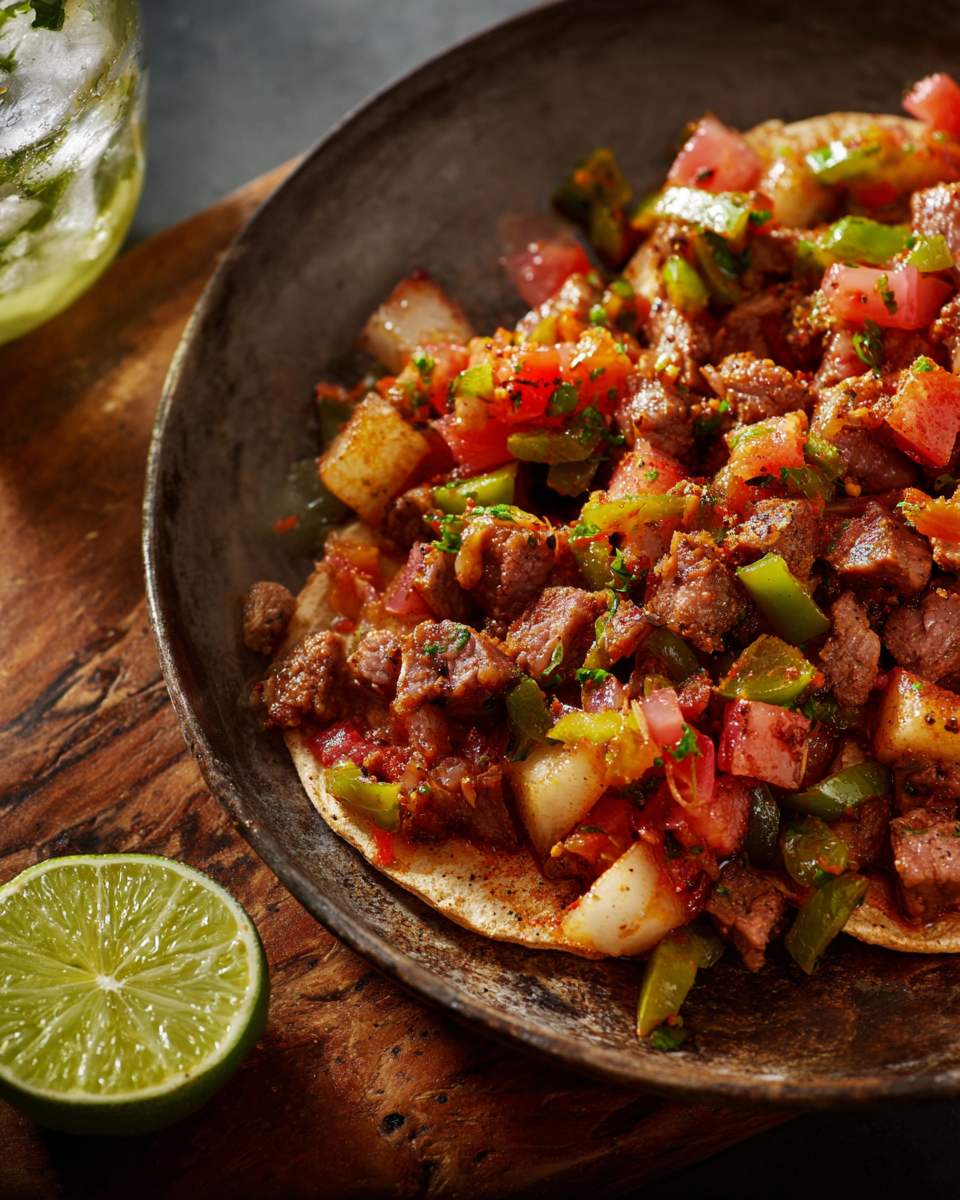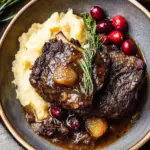The dish known as Discada Chihuahuense is a hearty, celebratory one-pan meal originating from the northern Mexican state of Chihuahua. Traditionally cooked outdoors in a large disco (a repurposed plow disc turned into a cooking surface), it blends pork, beef, spicy chorizo, crispy bacon, soft potatoes, vibrant chilies, and smoky chipotles into a rich, meaty medley.
Discada is more than just food—it’s a community event. Often made in large quantities for gatherings, birthdays, or fiestas, it’s the Mexican answer to a BBQ skillet feast. Loaded with layers of flavor and soul-warming ingredients, this dish serves up comfort in every tortilla-wrapped bite. Whether you’re in Texas, Chihuahua, or your home kitchen, Discada brings the fire, flavor, and fun.
Full recipe:
Ingredients:
-
240g (about 10 slices) bacon, chopped
-
500g Mexican chorizo, casing removed and chopped
-
500g Yukon gold or baby gold potatoes, peeled and diced (if using baby potatoes, leave the skin on)
-
1¾ tsp salt, divided (or to taste)
-
½ tsp black pepper, divided (or to taste)
-
1/2 large white onion, chopped (1½ cups)
-
250g fresh green chiles (chilaca, Anaheim, California, New Mexico, or Hatch), stemmed, seeded, and chopped
-
1 fresh jalapeño, stemmed and chopped
-
2 garlic cloves, finely chopped
-
750g ripe tomatoes, cored, seeded, and chopped
-
2 chipotle chiles in adobo, seeded and chopped
-
500g pork loin, diced small
-
500g beef loin, diced small
-
½ tsp ground cumin
-
2 tbsp vegetable oil
-
Warm corn tortillas, for serving
Directions:
-
Heat a large skillet or paella pan over medium-high heat. Once hot, add bacon and cook for 3–4 minutes until it begins to brown and release its fat.
-
Add the chorizo, breaking it apart with a spoon. Cook for about 2 minutes until browned and fragrant.
-
Stir in the potatoes, 1 tsp salt, and ¼ tsp pepper. Cook for 3–4 minutes to soften the potatoes and further brown the chorizo.
-
Add chopped onion, cook for another 2–3 minutes until translucent.
-
Stir in green chiles and jalapeño. Cook 2 more minutes.
-
Add garlic, stir and cook for 1 minute.
-
Add tomatoes and chipotles, stir and cook 3–4 minutes.
-
With a slotted spoon, remove all ingredients to a large bowl.
-
Season pork and beef with remaining salt, pepper, and cumin.
-
In the same pan, heat oil over high heat. Sear the meats for 5–6 minutes, until browned.
-
Return reserved veggie mixture to the pan, stir well, and heat through.
-
Serve hot with warm corn tortillas and your favorite salsa.
Prep Time: 15 minutes | Cooking Time: 25 minutes | Total Time: 40 minutes
Kcal: 480 kcal | Servings: 6 servings
A Symbol of Northern Mexican Culture
Discada Chihuahuense embodies the culinary spirit of northern Mexico—bold, rustic, and deeply rooted in community traditions. Its preparation is as much about the gathering as it is about the food. In rural settings, preparing discada is often a group activity, where family and friends contribute to the process, from chopping ingredients to standing around the disco, enjoying the smoky aromas and sharing stories. It’s a centerpiece dish, the kind that naturally brings people together.
The choice of ingredients in Discada Chihuahuense often reflects the region’s agricultural abundance and preference for strong, meaty flavors. The use of beef and pork—especially cuts like loin—paired with Mexican chorizo and bacon highlights the emphasis on protein-rich foods. These ingredients are commonly accessible in northern Mexico, where livestock farming is prominent.
Cooking Technique and Flavor Profile
What makes Discada Chihuahuense unique is not just the ingredients but the way it’s cooked. Using a wide, heated surface allows the cook to develop layers of flavor through sequential sautéing. Bacon is typically rendered first to release its fat, followed by chorizo, which adds intense seasoning and color. Potatoes are then added to absorb the flavorful fats, creating a starchy base that holds the dish together. Onion, garlic, and chilies are introduced next, infusing the skillet with aromatic depth and heat. Finally, ripe tomatoes and smoky chipotle chilies bring a tangy, slightly sweet and spicy finish.
After the vegetables and aromatics are cooked and set aside, the marinated pork and beef are seared until browned and slightly crispy. The final step involves reincorporating all the components into the skillet, allowing the flavors to marry and the dish to reach a unified, balanced taste. The result is a rich, savory medley of meats and vegetables with a hint of spice and a deeply satisfying, smoky undertone.
Though traditionally prepared on an outdoor disco, modern cooks can easily adapt the recipe for indoor stovetop cooking using a large, heavy skillet or wok. This makes Discada accessible to home cooks across the globe, while still retaining its cultural essence.
The Role of Spice and Smokiness
Spice in Discada Chihuahuense is carefully layered, not overpowering. The chilies used—such as chilaca, Anaheim, or Hatch—add a mild heat and vegetal complexity. Jalapeños bring in a sharper kick, while chipotle chilies in adobo sauce contribute a rich smokiness and depth. The use of cumin adds earthiness, grounding the dish and tying all the bold ingredients together.
This balance of spice and smoke is what makes Discada distinct. Unlike salsas or sauces where the heat can dominate, here the chilies play a supporting role, enhancing the natural flavors of the meats and vegetables. It’s a fine example of how Mexican cuisine uses heat not just for intensity but for dimension and nuance.
Tortillas: The Essential Accompaniment
No dish of Discada is complete without warm corn tortillas. These serve as the perfect vehicle for the rich mixture, transforming the dish into handheld tacos. Tortillas also play a symbolic role—representing the practicality and simplicity of Mexican food traditions. They are easy to serve, make the dish shareable, and absorb the rich juices from the meats and vegetables. In many gatherings, tortillas are kept warm in cloth-lined baskets or on comales, always within arm’s reach, ready to be filled.
You might find people garnishing their discada tacos with chopped onions, cilantro, or a splash of lime juice. Salsas of varying heat levels often make an appearance, allowing diners to personalize their tacos according to taste. The idea is not to complicate the dish but to enhance it, letting the core ingredients remain the stars of the show.
Modern Variations and Regional Twists
While the core of Discada Chihuahuense remains consistent—mixed meats, chilies, and vegetables—there are countless regional and personal variations. Some cooks incorporate hot dogs, ham, or bell peppers. Others might add beer or Coca-Cola for a touch of sweetness and caramelization during cooking. Some even introduce cheese toward the end, making the dish gooier and indulgent.
Outside of Chihuahua, discada has inspired its own subcultures of cooking. In Texas, for example, the dish is often grilled and served at barbecues, sometimes paired with grilled corn or rice. In Sonora, flour tortillas may replace corn, owing to regional preferences. These variations are a testament to the dish’s adaptability and enduring popularity.
Discada has also found a place in the fusion food world. Food trucks and modern Mexican eateries in urban centers have reimagined it as discada nachos, burritos, and even sliders—showing that while the dish is deeply traditional, it’s also remarkably versatile.
Community and Festivity Around the Dish
Beyond its culinary qualities, Discada Chihuahuense is about community. It’s often prepared for birthdays, weddings, and national holidays like Mexican Independence Day or Día del Trabajo (Labor Day). The process of making discada encourages participation—multiple hands chopping, stirring, and serving. It’s common to see entire families involved, from abuelos to niños, all contributing to the meal’s preparation or simply enjoying the moment.
Outdoor cooking is a key part of the experience. There’s an undeniable charm to standing around a sizzling disco with a cold drink in hand, surrounded by laughter, conversation, and the intoxicating aroma of sizzling meats and chilies. It’s this social and sensory richness that makes Discada more than just food—it becomes an event, a memory, a piece of cultural storytelling.
Even in more intimate settings, discada carries that communal energy. Cooking it indoors with friends or family still brings the same warmth and togetherness. It’s a meal that says, “Let’s gather.”
Conclusion
Discada Chihuahuense is more than just a mixed meat dish—it’s a representation of northern Mexican heritage, a celebration of community, and a shining example of how rustic, resourceful cooking can create deep and unforgettable flavor. From its origins in the fields of Chihuahua to modern adaptations in urban kitchens and food trucks, discada remains an iconic part of Mexican cuisine.
Its preparation style encourages creativity and inclusiveness, and its taste offers comfort and complexity in every bite. Whether you cook it on a traditional outdoor disco or in your home skillet, Discada Chihuahuense brings people together, turning simple ingredients into something truly extraordinary.
It’s not just a recipe; it’s a tradition—a delicious way to honor the past while savoring the present.






